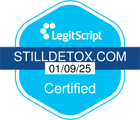What Is Cocaine? Understanding the Substance
Cocaine is a powerful stimulant derived from coca plant leaves, classified as a Schedule II drug by the DEA due to its high abuse potential and limited medical use (e.g., as a local anesthetic). It comes as a white powder (snorted, injected) or as crack (smoked), delivering a rapid, euphoric rush. Effects hit within seconds to minutes, peaking at 5-30 minutes, then fading fast, per a 2023 NIDA overview. Its allure lies in this intensity, but so does its danger—millions use it yearly, with addiction rates soaring.
How addictive is cocaine tied to its nature? At Still Detox, we explain to patients that its quick, potent high sets the stage for repeated use and dependence.
How Addictive Is Cocaine? Measuring the Risk
Cocaine ranks among the most addictive drugs due to its effect on dopamine, a brain chemical tied to pleasure. A 2021 Addiction Biology study estimates 15-20% of users develop dependence within two years, with crack users at higher risk (up to 25%) due to faster delivery. Its half-life is short—about 1 hour—driving frequent redosing as the crash hits within 30-60 minutes. The DEA notes cocaine’s addiction potential rivals methamphetamine, with animal studies showing self-administration rates doubling those of heroin. Human data from SAMHSA’s 2022 report shows 1.4 million U.S. users yearly, many escalating to addiction.
How addictive is cocaine in practice? At Still Detox, we see patients caught by its rapid reward cycle—its potency makes it a top challenge in recovery.
Why Is Cocaine So Addictive? Brain and Behavior
Cocaine floods the brain with dopamine by blocking its reuptake, amplifying reward signals 10 times normal levels, per a 2020 Neuropsychopharmacology study. This overstimulation rewires the brain’s reward system—prefrontal cortex and nucleus accumbens—prioritizing cocaine over natural pleasures like food or sleep. The crash—marked by fatigue, depression, and cravings—pushes users to redose, forming a cycle. Chronic use shrinks dopamine receptors, making sobriety feel unrewarding. Routes like smoking or injecting spike blood levels fast (10-60 seconds), intensifying this loop.
How addictive is cocaine neurologically? At Still Detox, we tell patients its brain changes explain why quitting feels so hard—it’s not just willpower, it’s biology.
Breaking Cocaine Addiction: Still Detox’s Approach
Cocaine’s addictiveness—compounded by withdrawal (irritability, paranoia, exhaustion within 24 hours)—demands robust treatment. No FDA-approved meds exist, but Still Detox uses medical detox to manage acute withdrawal, often with benzodiazepines for anxiety or sleep aids. Therapy is key: Cognitive Behavioral Therapy (CBT) rewires thought patterns, contingency management rewards sobriety, per a 2022 Journal of Substance Abuse Treatment study showing 60% retention in CBT programs. Holistic care—exercise, nutrition—rebuilds health after cocaine’s toll (e.g., weight loss, heart strain).
How addictive is cocaine in recovery? At Still Detox, we tackle its grip head-on—call (561) 556-2677 if cocaine’s hold affects you or a loved one.








